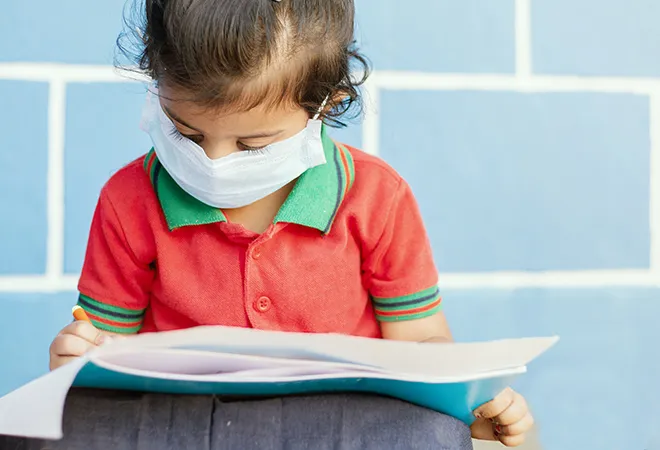
Education worldwide has been one of the biggest victims of COVID-19. In response to COVID-19, schools and institutions of higher learning have been shut down for indefinite periods. According to UNESCO, the countrywide school closure in India has affected 320 million children enrolled from pre-primary to tertiary levels of education. It has been estimated that of these, about 158 million are female students. While school closures are an essential precautionary measure, it is likely to bring other related risks to millions of girls and young women in countries where attaining education is already a struggle on account of gender bias.
During the Ebola crisis, a large number of girls dropped out of school due to an increase in domestic, caring responsibilities as well as a shift towards income generation. In most cases, boys were prioritised over girls to attend school. Owing to similar socio-economic settings, where the burden of unpaid domestic and care economy is largely carried by girls and women, India may face identical consequences in the foreseeable future.
Even before the COVID-19 crisis, it was found that girls who engage in two hours of housework per day had a lesser probability of finishing secondary school in the country. In India, where limited social security nets are in place, the financial and social hardships caused by the pandemic can only exacerbate the gender inequality in education. Post pandemic, this can lead to a higher risk of girls permanently dropping out of school and reversing the gains made in recent years.
Lessons on school drop-outs from Ebola crisis
School closures can have a disproportionate impact on countries where girls’ education already lags behind that of boys. The economic hardships caused due to the pandemic may spill over and affect girls’ educational status. The increasing domestic financial burden is likely to force parents to evaluate the opportunity cost of sending girls to school, thus preventing their re-enrollment.
In 2014, the Ebola epidemic led to a similar countrywide lockdown in the African countries of Guinea, Liberia and Sierra Leone, where more than 10,000 schools were closed down, affecting nearly five million children. According to a study, when the schools reopened six months later, the students had lost approximately 1,848 hours of education that ranged from 33 weeks in Guinea to 39 weeks in Sierra Leone.
Drawing on the data from the Ebola epidemic in Sierra Leone, the study calculated the potential impact of the current school closures on girls’ dropout numbers. It estimated that the simple loss of six months of education as a result of COVID-19 will have a proportionally larger impact on girls in low- and lower-middle-income countries. Some countries could lose up to 50 percent of their total years of education, while about 10 million more secondary school-aged girls could be out of school following the pandemic, the study estimated.
Health, hygiene and safety
In countries like India, girls face barriers to education daily due to poor infrastructure, cultural norms and poverty. Schools, in such countries, go beyond the objective of providing education by serving other functions that help in maintaining health, hygiene, psycho-social support and safety for girls.
Schools often allow equal opportunity to avail resources such as food, water and sanitation facilities for girls. While much more ground still needs to be covered in this regard, several schools over the years have helped girls fight the taboo around menstruation and provide sanitary products to maintain reproductive health and hygiene. Schools also shelter girls from abusive and violent domestic atmospheres. The closure of schools has not only affected the availability of proper nutrition and sanitary facilities for the girls, but has also made them more vulnerable to physical and sexual violence.
In the aftermath of the Ebola crisis, Sierra Leone saw a substantial rise in adolescent pregnancy, which was directly linked to the closure of schools. In most cases, pregnancy became a permanent barrier for a girl to return to school. The inaccessibility of sexual and reproductive health services led to an increase in teenage pregnancies, maternal health risks and unwanted births. Closing down schools also led to rising cases of transactional sex, child labour and child marriage, as a means to reduce economic burden.
Retaining girls in schools
At a national level, the flow of funds for education must remain unhindered. Recovery planning must account for gender budgeting, tracking students and assessing loss due to school closures. Scholarships, waiving off the fees for girls’ education, providing free learning supplies can be considered to reduce the economic burden on parents. Moreover, access to sanitation facilities, food and water should be restored on the reopening of schools.
At the local level, gender must be factored in while resuming schools post the COVID-19 crisis is overcome. It is important that sex-disaggregated and decentralised data is locally collected to monitor girls’ attendance on the reopening of schools. Remedial and additional courses can be adopted to catch up with the lost academic schedule. School principals and administrative authorities can also follow-up on girls dropping out of schools. Further, constant communication and outreach should be available for vulnerable populations. Community engagement can be improved with the help of Aanganwadi workers and Accredited Social Health Workers (ASHAs) to ease the access to essential services like meal provisions and sanitary products. Communication channels should be strengthened to monitor and report instances of domestic violence or forced marriages.
India’s digital divide will only further the education gap that already exists. While internet penetration in India is pegged at around 36 percent, only 12.5 percent of the households with school-going students in India are estimated to have internet access at home. In such a scenario, it is not possible to mitigate the challenges arising from school closures merely through online learning. Alternate remedies must be adopted to prevent the reversing of developmental gains. During the Ebola outbreak, learning through low-tech radio programmes was more accessible and feasible than online learning options.
Planning for the future and learning from the past will enable the government to take measures to resume schools and prevent potential losses that can occur due to the lockdown. A gendered approach in planning for the post-crisis reconstruction of the education system will help mitigate the larger-scale irreparable consequences of COVID-19 for girls and young women.
The author is a Research Intern, ORF Mumbai
The views expressed above belong to the author(s). ORF research and analyses now available on Telegram! Click here to access our curated content — blogs, longforms and interviews.




 PREV
PREV


